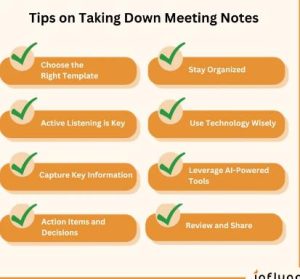What Are the Best Practices for Taking Effective Meeting Notes?
Taking effective meeting notes is a critical skill that enhances productivity and ensures clarity in workplace communication. Proper note-taking captures essential information, assigns actionable items, and serves as a historical document for reference. Let’s explore the best practices for mastering this skill.

Prepare in Advance
Choose the Right Tools Select tools that you are comfortable with, whether digital or traditional. Digital tools like note-taking apps can offer advantages such as searchable text and easy sharing options. Approximately 65% of professionals in a 2024 survey preferred digital note-taking for its convenience and efficiency.
Review the Agenda Understanding the meeting’s agenda beforehand can significantly increase the effectiveness of your notes. A preview allows you to outline your notes in advance, leaving you better prepared to capture relevant details rather than scrambling to keep up with the discussion.
Capture the Essentials
Focus on Key Points Instead of trying to write down everything, focus on capturing key points, decisions, and assignments. Data from Time Management Corp. shows that notes focused on critical elements rather than verbatim accounts are 40% more likely to be used in follow-up actions.
Use Bullet Points and Headings Organize information using bullet points and headings to make your notes easy to skim and review. This structured approach helps in identifying major topics and action items quickly.
Record Decisions and Action Items Clearly note any decisions made and actions that need to be taken, including who is responsible for what and the deadlines. These are often the most critical pieces of information needed after a meeting.
Utilize Symbols and Abbreviations Develop a system of symbols and abbreviations for common terms or phrases used frequently within your organization. This can save time and keep your notes concise.
Review and Refine
Summarize Key Points at the End At the meeting’s conclusion, take a moment to summarize the key points discussed. This helps solidify your understanding and ensures you have captured the necessary information accurately.
Clarify Uncertain Points If there’s anything you didn’t understand during the meeting, don’t hesitate to ask for clarification before everyone leaves. This ensures your notes are accurate and reflective of the discussion.
Distribute and Follow Up
Share Notes Promptly Share your notes with all relevant parties soon after the meeting. Timely distribution helps keep everyone aligned and informed, especially those who were unable to attend.
Use Notes for Follow-Up Refer back to your notes when completing action items or preparing for follow-up meetings. They should serve as a clear guide for next steps and responsibilities.
Incorporating these Practices
By implementing these strategies on how to take effective meeting notes, you ensure that your notes are an invaluable resource for yourself and your colleagues. Effective note-taking not only improves productivity but also enhances communication and project tracking within teams. Remember, the goal of taking notes is to make information easier to understand and act upon, not just to record words spoken during a meeting.